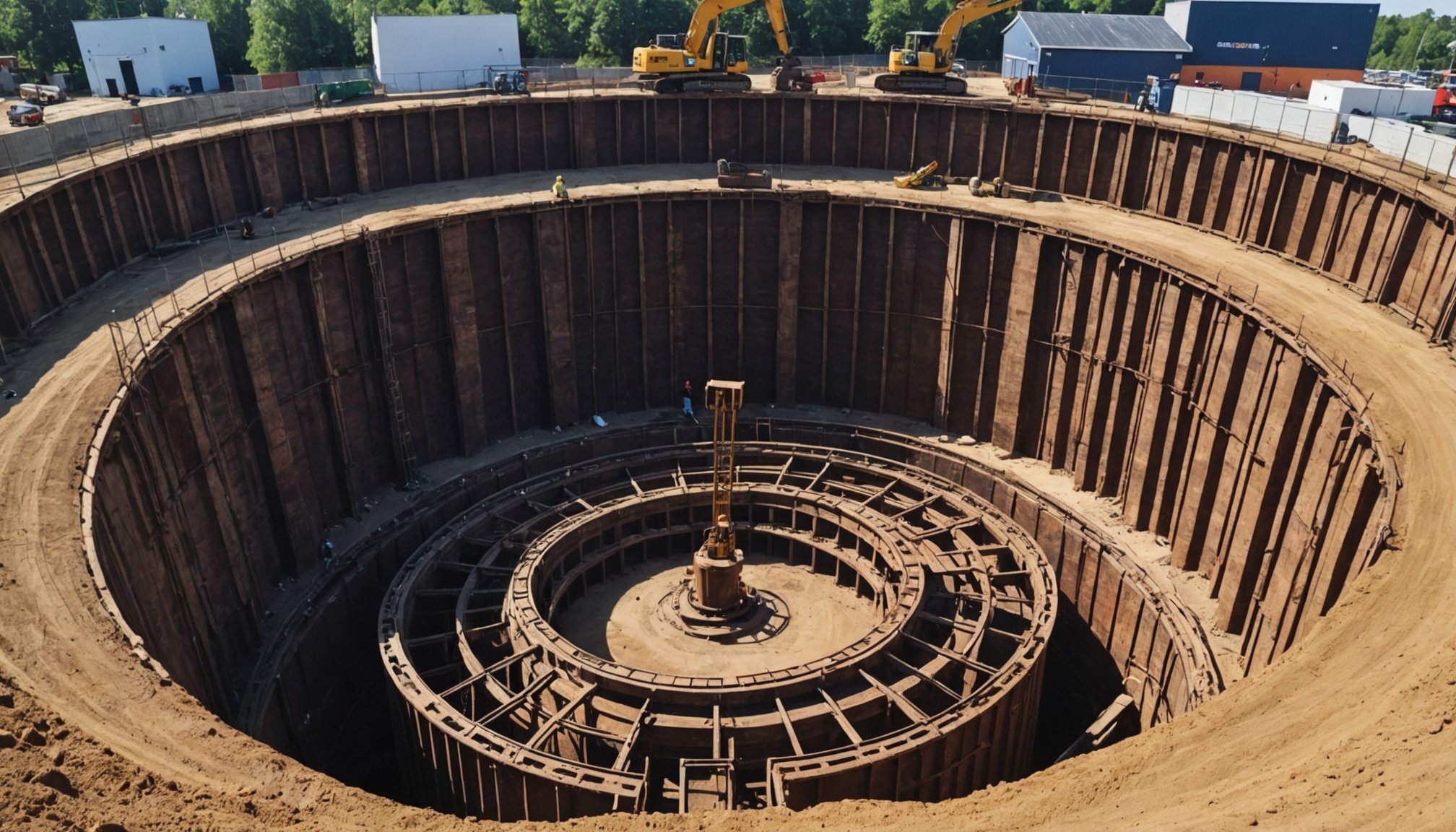Secant pile walls offer a robust solution for deep excavation challenges, combining structural strength with effective ground and water control. Their adaptability to complex site conditions and minimal impact on surrounding structures makes them indispensable for urban and sensitive environments. Understanding these benefits highlights why secant pile walls remain a top choice among construction professionals seeking safety, efficiency, and reliability in demanding projects.
Primary advantages of secant pile walls in deep excavation
Secant pile walls offer significant benefits in deep excavation projects, chiefly by providing exceptional ground control and structural stability. These walls are formed by intersecting reinforced concrete piles, resulting in a continuous, reinforced barrier that resists soil movement effectively. This method excels in challenging site conditions where other retaining systems might fail, such as in soft or water-bearing soils.
In the same genre : Transform your dental practice with expert accountant services
One primary benefit of secant pile walls is their ability to minimize ground settlement and lateral soil displacement during excavation. This precise ground control reduces risks to adjacent structures and utilities, making secant pile walls a preferred solution in urban or confined environments. They also provide excellent watertightness, crucial in groundwater-rich construction sites, thereby controlling seepage and maintaining a dry excavation area.
In addition, secant pile walls are highly adaptable to varying depths and soil conditions. Their installation allows for flexibility in pile diameter, length, and reinforcement to match specific project requirements, presenting a reliable approach for deep excavation challenges. The robustness and durability of these walls ensure long-term performance, even in the most demanding geotechnical scenarios.
Also to discover : How are uk business services revolutionizing their approach in the digital economy?
For a detailed understanding of these robust retaining structures, exploring the engineering principles behind Secant Piled Walls can shed further light on why they stand out as the solution of choice for ground control in complex excavations.
Superior ground water control
Delivering robust excavation water management with secant pile walls
Secant pile walls for water control serve as a critical technology in modern excavation projects. By creating an interlocking barrier of concrete piles, these walls effectively prevent water ingress into deep excavations. This barrier function is essential for maintaining dry and stable work environments, especially in areas with high groundwater levels or permeable soils.
How do secant pile walls improve excavation water management? They act as impermeable walls that significantly reduce groundwater flow into the excavation site. This reduction in water infiltration minimizes the risk of soil instability and prevents flooding, which could otherwise compromise safety and construction schedules. The solid structure formed by overlapping piles ensures little to no leakage, maintaining excavation integrity throughout the project.
Furthermore, superior excavation water management achieved with secant pile walls enhances worker safety and operational efficiency. By controlling groundwater, dewatering requirements are lessened, which can reduce the need for extensive pumping systems. This leads to cost savings and lower environmental impact. Additionally, the stability provided by these walls mitigates hazards related to sudden water inflows or soil collapse, securing the site for the duration of construction activities.
In summary, employing secant pile walls for water control offers a dependable solution to the challenges posed by groundwater during deep excavation. Their ability to form a watertight barrier contributes directly to safer, more efficient, and cost-effective excavation water management.
Enhanced structural stability for deep excavations
Deep excavations demand robust excavation support systems to maintain structural stability. Secant pile walls excel in this area due to their exceptionally high load-bearing capacity. This capacity ensures the wall can resist significant earth pressures and external loads without deformation or collapse, which is critical in challenging soil conditions.
One key advantage of secant pile walls is their ability to provide reliable support even in soft or unstable soils. These walls are constructed by overlapping reinforced concrete piles, creating a continuous barrier that resists lateral soil movement effectively. The interlocking nature of the piles means the system is highly resistant to ground heave and water ingress, both common risks during deep excavation projects.
Secant pile walls distribute loads evenly and can withstand varying subsurface pressures, enhancing overall load resistance. This stability not only protects the excavation site but also safeguards adjacent structures and infrastructure, minimizing the risk of settlement or damage during construction.
Minimal ground movement during construction
Small shifts in soil or structures during excavation can cause significant problems. Effective ground movement control is essential to reduce settlement and disturbance to adjacent buildings or infrastructure. Minimising such impacts ensures construction activities do not lead to cracks, tilting, or long-term damage.
Using proven construction methods helps achieve precise control, limiting ground vibrations and soil displacement. This is especially critical in dense urban settings or sensitive environments where existing foundations and utility networks are vulnerable. Reduced ground movement safeguards neighbouring properties and maintains public safety.
By carefully planning and implementing strategies focused on construction impact minimisation, projects can proceed smoothly without compromising nearby structures. For example, employing techniques such as Secant Piled Walls enhances stability and significantly curtails ground settlement during deep excavations, thereby protecting surrounding areas.
In sum, meticulous ground movement control benefits both the construction process and community wellbeing by preventing costly structural damage and ensuring environmental protection.
Flexibility in adapting to complex site conditions
Secant pile walls are renowned for their flexibility in adapting to complex site conditions, making them an excellent choice for projects involving irregular excavation or tight urban construction sites. Their design inherently allows for accommodation of varying site geometries, which is critical when facing unconventional or restricted work areas.
Unlike traditional retaining structures, flexible wall systems such as secant pile walls can be customised to fit unique contours and spatial limitations. This adaptability means that even in congested locations—where space is scarce and construction zones are complex engineers can tailor the wall layout precisely to the site’s requirements. The piles themselves are installed by drilling and concreting methods that allow modification of shape and alignment to navigate around existing underground utilities or other obstacles without compromising structural integrity.
Moreover, in urban construction environments, where irregular excavation is frequent due to neighboring buildings or infrastructure, secant pile walls provide a reliable, adaptable solution. By creating overlapping concrete columns, the system forms a continuous retaining wall that conforms seamlessly to the excavation boundary. This ensures stability while minimizing disturbance to adjacent structures.
If your project involves highly irregular excavation patterns or tight urban sites, choosing flexible wall systems like secant piles not only enhances construction feasibility but also provides long-term support tailored to the site’s precise conditions. For deeper insight into this versatile method, exploring resources on Secant Piled Walls can be invaluable.
Rapid and efficient installation process
Speed and efficiency are critical in construction, especially for deep excavation projects employing secant piled walls. The fast installation of these walls hinges on techniques designed to streamline the building process, thereby enhancing overall construction efficiency and shortening the project timeline.
One key method involves the use of continuous piling sequences where primary and secondary piles are installed rapidly in succession. This technique reduces waiting times between pile installations and allows the wall structure to form swiftly. Additionally, employing advanced drilling rigs and automated cutting tools minimizes manual labor, accelerating progress without compromising precision.
Minimising excavation project delays is crucial. Secant piled walls can be installed with minimal disruption to surrounding operations because their installation does not require extensive support frameworks or soil replacement phases. This reduces environmental impact and allows other construction activities to proceed concurrently, improving construction efficiency.
Incorporating these methods fosters a construction environment where timelines are predictable and delays are less frequent. For projects aiming at rapid ground support solutions, focusing on fast installation techniques for secant piled walls is a strategic approach to achieving timely completion while maintaining structural integrity.
Comparisons with alternative excavation support systems
Understanding performance and applications
The choice between secant pile walls vs diaphragm walls often hinges on specific project requirements such as soil conditions, water control needs, and budget constraints. Secant pile walls provide a rigid retaining wall system formed by overlapping concrete piles, offering excellent groundwater cutoff capabilities. In contrast, diaphragm walls are cast-in-situ reinforced concrete walls built in narrow trenches, commonly used where very tight excavation tolerances and minimal ground movement are critical.
When considering retaining wall systems comparison, water control performance is a key differentiator. Secant pile walls excel in controlling groundwater infiltration due to their overlapping piles, which create a near-impermeable barrier. This makes them particularly suitable for sites with high water tables or when dewatering is costly. Diaphragm walls also provide robust water resistance but typically require additional waterproofing treatments to match the effectiveness of secant pile walls.
Structurally, secant pile walls are highly adaptable, allowing for curved alignments and variable excavation depths. They often result in faster installation times compared to diaphragm walls, translating into potential cost savings. However, diaphragm walls can achieve greater stiffness and load-bearing capacity when heavily reinforced, making them preferable for deep excavations under challenging load conditions.
Typical application scenarios for secant pile walls include urban sites with limited access, irregular excavation shapes, or where groundwater control is paramount. In contrast, diaphragm walls are often chosen for large-scale infrastructure projects requiring deep, vertical excavations with stringent deflection limits. For more complex projects balancing these factors, understanding the detailed differences between these retaining wall systems is critical for optimal design.
Real-world application scenarios and expert insights
Urban deep basement projects
In urban construction, deep basements are essential for maximizing space without expanding footprints. Experts emphasize the critical role of reliable retaining systems, such as secant piled walls, to ensure structural safety during excavation. Secant piled walls provide excellent groundwater control and soil support, making them ideal for urban deep basement projects where space and stability are paramount.
Infrastructure development case examples
Numerous infrastructure projects demonstrate the effectiveness of secant piled walls. For example, complex transportation hubs often require deep excavation near existing structures. Secant piled walls serve as robust barriers that minimize soil movement and protect surrounding infrastructure. Their adaptability to varying ground conditions makes them a preferred solution in diverse case studies across the globe.
Perspectives from geotechnical engineers
Geotechnical experts highlight that selecting the most suitable retaining system requires thorough site investigation and soil analysis. Secant piled walls stand out due to their reliability and performance under challenging conditions. Engineers value their flexibility in design, allowing adaptation to specific project requirements. According to expert opinions, these walls significantly reduce construction risks, enhancing overall project success and safety. For those interested in a deeper technical understanding, exploring detailed resources on Secant Piled Walls can offer valuable insights.











